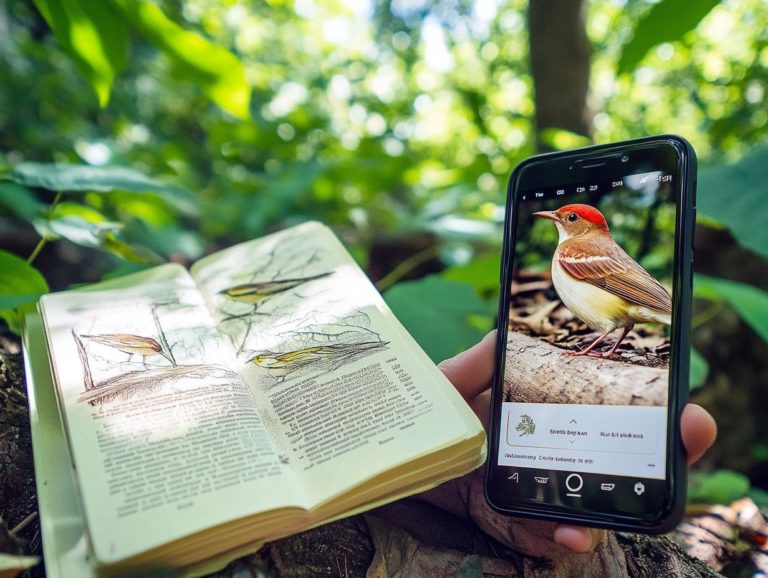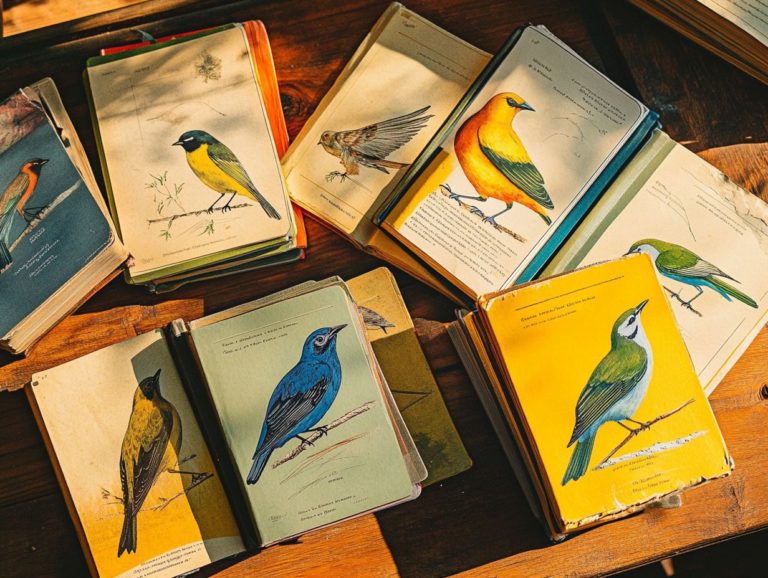Field Guides and Their Role in Birding Culture
Field guides have always been essential companions for bird enthusiasts like you, enhancing your outdoor enjoyment while identifying and appreciating the beauty of avian life.
From their humble beginnings to the sleek, modern editions available today, these guides have undergone a remarkable evolution. They mirror shifts in birding culture and advancements in technology, including innovations in citizen science, where everyday people contribute to scientific research.
This article delves into the history of field guides, highlighting their significance in deepening your understanding of birds. It also includes practical tips for selecting and utilizing them effectively.
As you look to the future, it s worth considering how technological innovations are reshaping these invaluable resources. Jump in and uncover how field guides can elevate your birding adventures!
Contents
- Key Takeaways:
- The History of Field Guides
- The Importance of Field Guides in Birding
- Choosing the Right Field Guide
- Tips for Using a Field Guide Effectively
- The Future of Field Guides
- Frequently Asked Questions
- What are field guides and how do they play a role in birding culture?
- What makes field guides an essential tool for birders?
- Are field guides only used by beginners in birding?
- Can field guides be used for birding in different regions?
- What types of field guides are available?
- Can field guides help with birdwatching anywhere?
Key Takeaways:
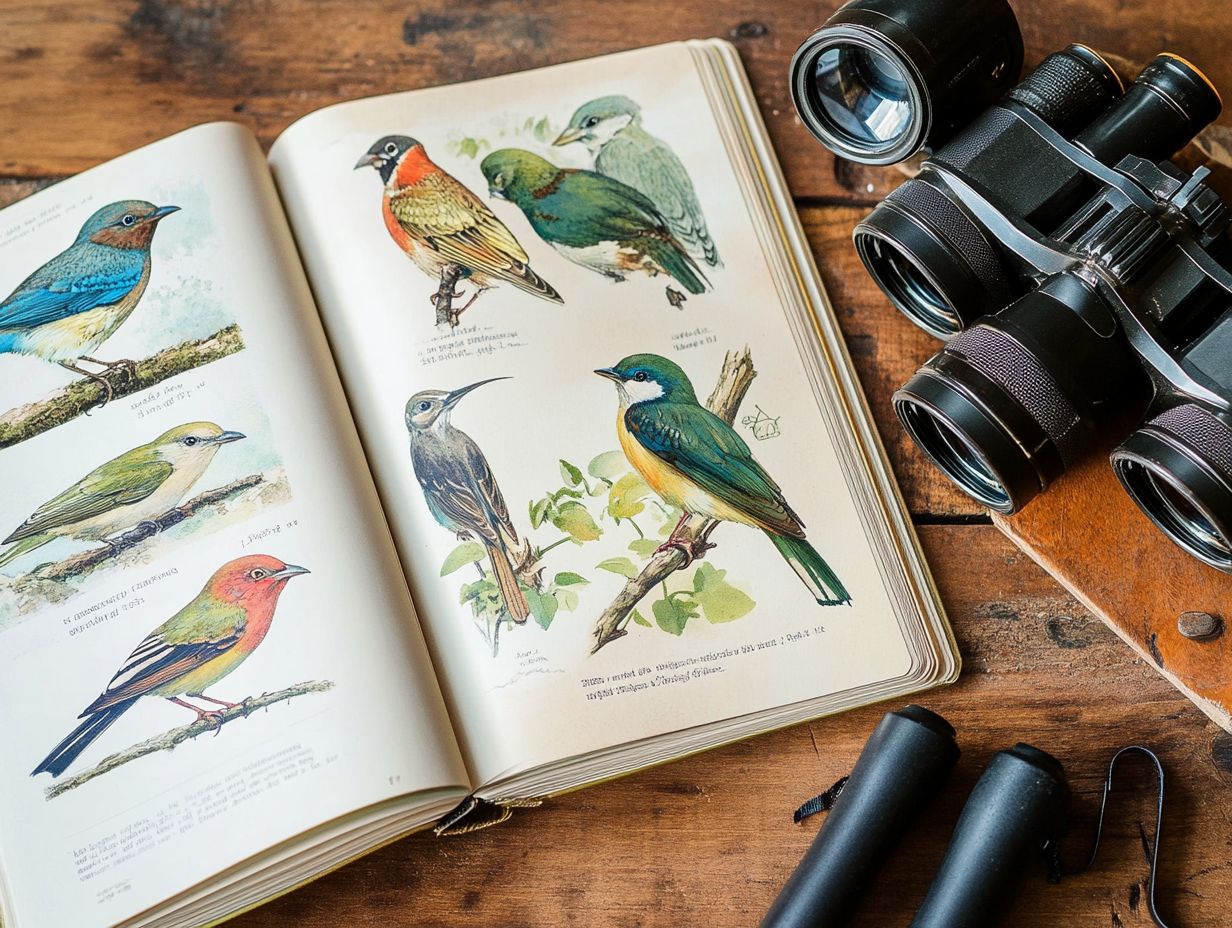
- Field guides have a long history, evolving from simple illustrations to modern, comprehensive guides.
- They play a crucial role in birding, aiding in identification and contributing to conservation efforts.
- When choosing a field guide, consider accuracy, ease of use, and portability.
The History of Field Guides
The history of field guides is rooted in the endeavors of early naturalists who aimed to catalog and visually represent the astonishing diversity of wildlife. Pioneering figures like Roger Tory Peterson and Ken Keffer set the stage for countless outdoor enthusiasts who followed in their footsteps.
Their groundbreaking works, such as the Golden Guide and the Sibley Guide, have elevated bird identification into a beloved pastime. These field guides enable both novice and seasoned naturalists to immerse themselves in the complexities of nature exploration, wildlife conservation, and species identification.
Early Field Guides and Their Evolution
Early field guides, crafted by figures like Roger Tory Peterson, revolutionized the way you classify and visually identify species. They greatly enhanced your field skills with breathtaking illustrations of birds, captivating outdoor enthusiasts and making learning an engaging experience.
As your appreciation for environmental literacy deepens, you ll notice that these guides have evolved alongside it. They foster a richer connection to the natural world and encourage hobbies like backyard gardening. What once began as simple checklists has transformed into comprehensive resources that explore behavioral patterns and habitats.
Influential texts, like the National Audubon Society s bird guide, spotlight visual learning through stunning imagery. They also cultivate a heightened sense of ecological awareness. This evolution reflects a broader trend in nature literature, where the focus has shifted from mere identification to creating an immersive ecological experience that inspires both novice explorers and seasoned nature aficionados.
The Rise of Modern Field Guides
The emergence of modern field guides beautifully aligns with a growing focus on citizen science and wildlife observation. This allows you, as a nature enthusiast, to engage more profoundly with your ecological adventures.
These guides, often enhanced by cutting-edge digital applications, are essential companions whether you’re a novice birdwatcher or a seasoned explorer. Features like interactive maps and auditory species identification enable you to share your discoveries with fellow nature lovers.
Imagine the thrill of using augmented reality (a technology that overlays digital information in the real world) to identify flora and fauna in real-time, transforming your outdoor experience into something truly immersive. User-generated content cultivates a vibrant community, enhancing your ecological adventures where every outdoor pursuit is celebrated.
These advancements amplify the joy of identifying species and contribute to a shared understanding of biodiversity. They ultimately enrich your personal experiences in nature.
The Importance of Field Guides in Birding
Field guides are essential companions in your birding adventures. They enhance your outdoor experience by equipping you with the tools needed to connect with nature and improve your visual identification skills. Utilizing field guides: a pathway to birding mastery enables you to identify various species and actively participate in wildlife conservation efforts, transforming each outing into a meaningful journey that supports conservation across diverse habitats.
Facilitating Identification and Learning
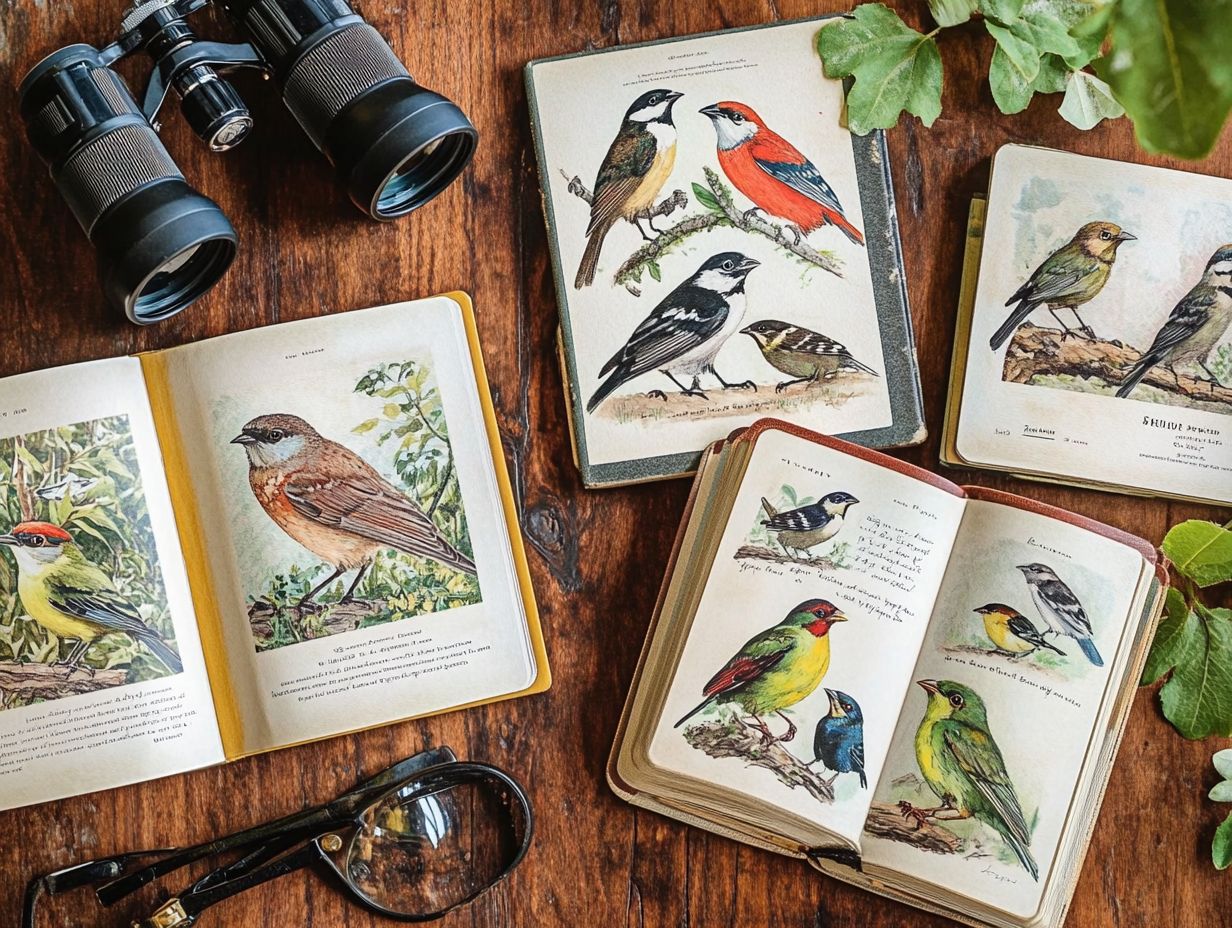
Field guides are your gateway to learning how to identify different birds, enabling you to navigate the outdoors with confidence. They transform your birdwatching hobby into an enriching adventure, highlighting the importance of field guides in bird watching by offering valuable insights into the unique traits of various birds.
By honing in on visual learning strategies, you can compare illustrations and photographs of birds to your real-life sightings, sharpening your ability to distinguish those subtle features color patterns, sizes, and vocalizations that make each bird special. It s immensely beneficial to jot down notes directly in the guides, capturing observed behaviors and favored habitats, which deepens your overall learning experience.
Pairing field guides with apps takes your exploration to the next level, granting you instant access to audio references. Now you can match calls and songs, elevating your pursuit of knowledge about birds into a truly rewarding journey.
Contribution to Conservation Efforts
Field guides play a key role in conservation efforts by helping you appreciate nature more and enabling you to engage in wildlife conservation through organized bird clubs and community projects, making them essential for every birdwatcher.
These resources provide essential information and serve as a vital link, connecting you and your community with the natural world around you. For instance, when you dive into citizen science projects, which allow regular people to help scientists by collecting data about local wildlife, you may find yourself monitoring local wildlife populations or taking part in habitat restoration initiatives. This engagement boosts your understanding of nature and fosters a sense of stewardship that is both rewarding and impactful.
Success stories, like the remarkable recovery of the Bald Eagle driven by community-led initiatives and awareness campaigns, demonstrate how informed individuals can transform into powerful advocates for conservation.
Ultimately, field guides do more than simply inform they ignite collective action and cultivate a deep appreciation for the intricate balance of our ecosystems.
Choosing the Right Field Guide
Selecting the ideal field guide is crucial for achieving success in bird identification, especially when considering factors like illustrations of birds and the quality of the content. You ll want to consider several factors, such as the guide’s accuracy, the quality of its illustrations, and the particular region it addresses.
Notable options like the Sibley Guide and the Golden Guide consistently stand out among the best choices available for nature lovers and bird watchers.
Factors to Consider
When selecting a field guide, you should consider several key factors, such as the accuracy of species names, the quality of bird illustrations, and the overall user-friendliness of the guide to enhance your birdwatching hobby.
These elements collectively shape your bird identification journey, enriching the experience whether you’re a novice or a seasoned birdwatcher. Accurate species names not only facilitate effective communication but also enhance your learning process, allowing you to correctly identify your feathered companions and deepen your appreciation for the natural history of these unique species. High-quality illustrations are essential; they provide the visual cues that can make all the difference between similar-looking varieties. User-friendliness is crucial an intuitive layout with clear indexing can significantly reduce the frustration that often accompanies sifting through vast amounts of information.
As you evaluate different guides, take the time to flip through the pages, assess the clarity of the images, and observe how well the content flows. This will ensure that the guide resonates with your personal exploration style and meets your needs as an aspiring birdwatcher, enriching your nature appreciation.
Tips for Using a Field Guide Effectively
Utilizing a field guide effectively is essential for maximizing your wildlife observation and accurately identifying species in the field. By employing various strategies, you can significantly enhance your outdoor experience. Transform each excursion into a rewarding adventure that includes wildlife observation and hiking trips.
How to Maximize Its Use in the Field
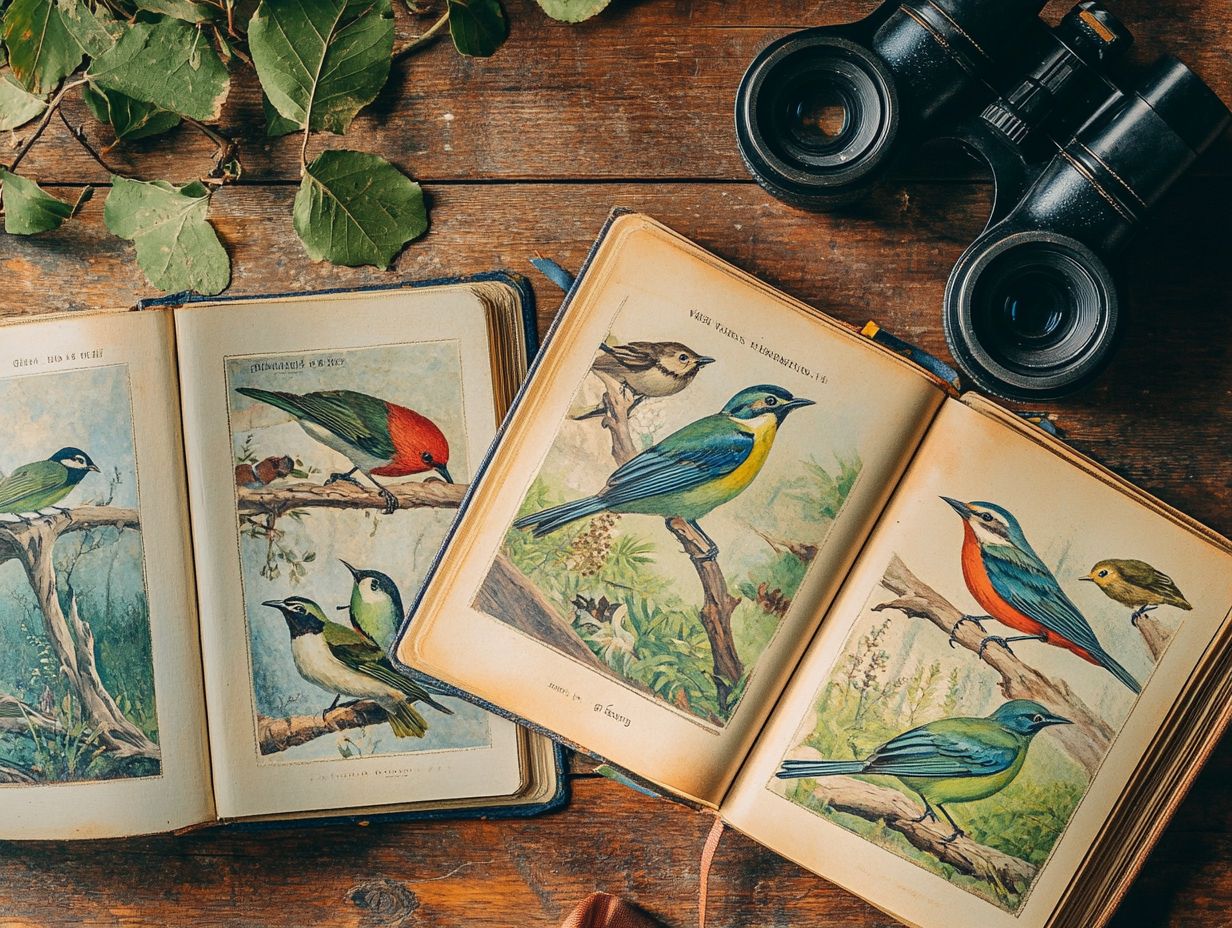
To make the most of a field guide during your outdoor adventures, it’s essential to familiarize yourself with its layout and structure. This preparation allows for quick reference and effective wildlife photography opportunities.
Start by checking the regional species and plant identification before you set out on your trip. This ensures you can swiftly locate your subjects. Engaging in visual learning by studying images in advance can significantly enhance your identification skills, boosting your confidence during outdoor activities and wildlife photography.
For example, memorizing distinctive characteristics like leaf shapes or animal markings is crucial when you re trying to spot elusive wildlife through your lens. Taking the time to differentiate between similar species can help eliminate confusion. This allows you to capture breathtaking photographs and deepen your appreciation for nature’s incredible biodiversity, which extends to both wildlife and plants.
The Future of Field Guides
The future of field guides is on the brink of transformation, driven by technological advancements and the evolving trends in birding culture. As more enthusiasts immerse themselves in nature outings and engage in citizen science initiatives, resources like field guides for enhancing your birdwatching experience will become increasingly valuable, setting the landscape of birding to change dramatically.
Technological Advancements and Changes in Birding Culture
Technological advancements have profoundly transformed birding culture. Digital field guides elevate your wildlife observation game and streamline the birdwatching process.
This evolution simplifies real-time species identification for you and connects a wider community of nature enthusiasts. Online platforms allow you to share your observations, fostering collaborative efforts in tracking migrations and deepening your understanding of local ecosystems.
The integration of apps and social media cultivates a sense of camaraderie. You can exchange tips, photos, and firsthand accounts of your outdoor adventures. As a result, your birding experience becomes richer and more inclusive, inviting both newcomers and seasoned watchers into a vibrant community dedicated to the appreciation of avian wildlife.
Frequently Asked Questions
What are field guides and how do they play a role in birding culture?
Field guides are books or digital resources that contain information and illustrations of different species of birds. They play a crucial role in birding culture by helping birders identify and learn about the birds they observe in the wild, as highlighted in field guides: bridging knowledge gaps in birding.
What makes field guides an essential tool for birders?
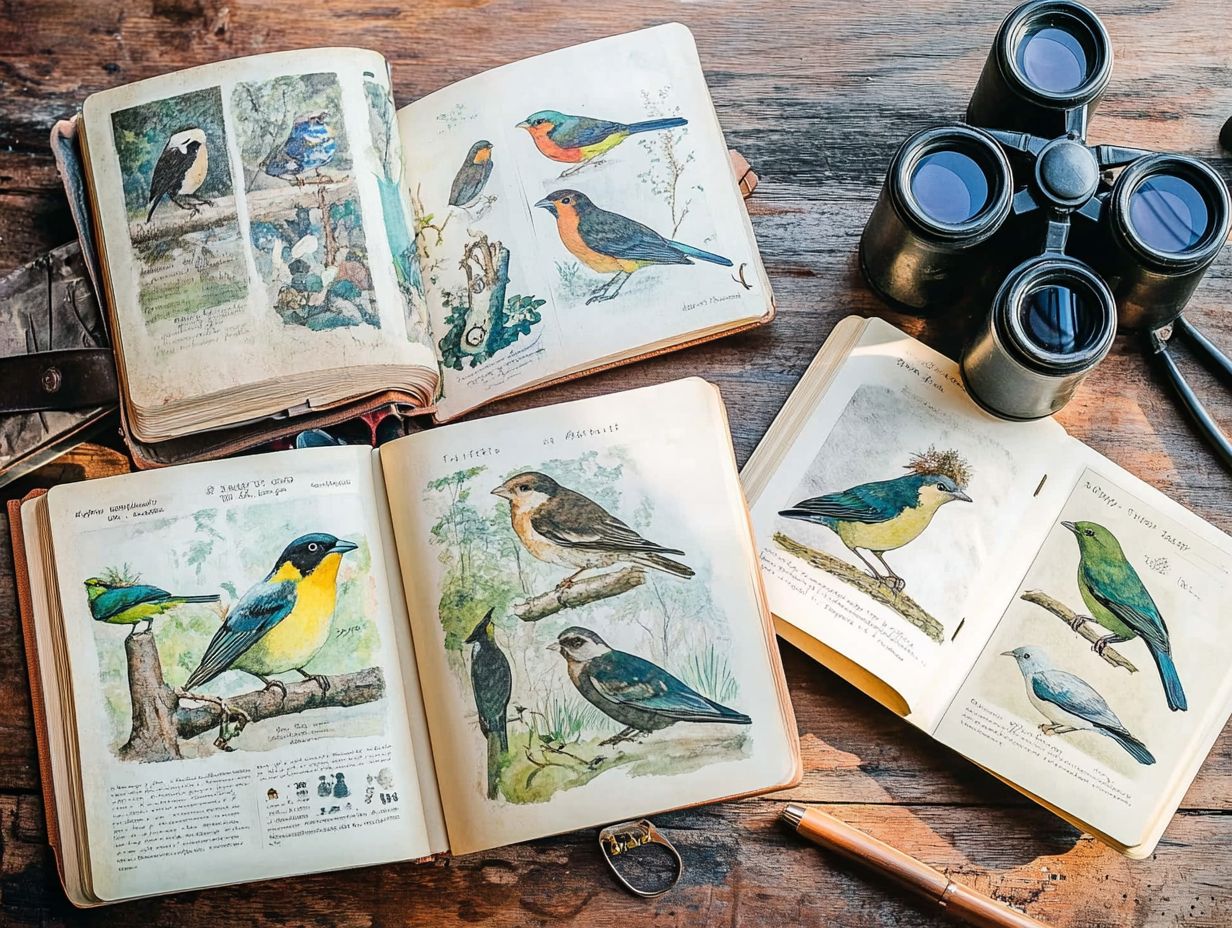
Field guides provide important information such as physical descriptions, behavior, and distribution of bird species. They also include illustrations or photographs to aid in identification, making them a key tool for bird conservation and an indispensable resource for birders of all levels.
Are field guides only used by beginners in birding?
No, field guides are used by birders of all levels, from beginners to experienced birders. Even experts use field guides as a quick reference or to learn about new or unfamiliar species they encounter in the field.
Can field guides be used for birding in different regions?
Yes, most field guides cover a wide range of bird species found in a specific geographic region. Some may even cover multiple regions or continents. However, it is always best to use a field guide specific to the region you are birding in for accurate information and identification.
What types of field guides are available?
Field guides come in various forms, including print books, digital apps, and online resources.
Some specialize in specific bird groups, like waterfowl, raptors, or seabirds.
Can field guides help with birdwatching anywhere?
Absolutely! Field guides are great for birdwatching both in the field and at home.
Many birders use them to identify birds, learn about their behavior, and plan future trips.




